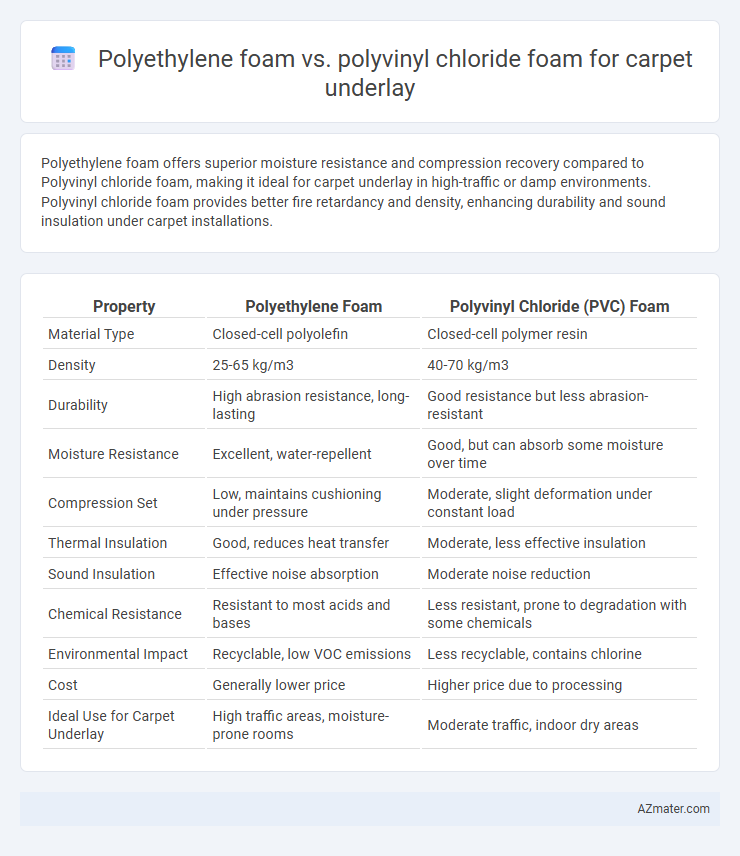Polyethylene foam offers superior moisture resistance and compression recovery compared to Polyvinyl chloride foam, making it ideal for carpet underlay in high-traffic or damp environments. Polyvinyl chloride foam provides better fire retardancy and density, enhancing durability and sound insulation under carpet installations.
Table of Comparison
| Property | Polyethylene Foam | Polyvinyl Chloride (PVC) Foam |
|---|---|---|
| Material Type | Closed-cell polyolefin | Closed-cell polymer resin |
| Density | 25-65 kg/m3 | 40-70 kg/m3 |
| Durability | High abrasion resistance, long-lasting | Good resistance but less abrasion-resistant |
| Moisture Resistance | Excellent, water-repellent | Good, but can absorb some moisture over time |
| Compression Set | Low, maintains cushioning under pressure | Moderate, slight deformation under constant load |
| Thermal Insulation | Good, reduces heat transfer | Moderate, less effective insulation |
| Sound Insulation | Effective noise absorption | Moderate noise reduction |
| Chemical Resistance | Resistant to most acids and bases | Less resistant, prone to degradation with some chemicals |
| Environmental Impact | Recyclable, low VOC emissions | Less recyclable, contains chlorine |
| Cost | Generally lower price | Higher price due to processing |
| Ideal Use for Carpet Underlay | High traffic areas, moisture-prone rooms | Moderate traffic, indoor dry areas |
Introduction to Carpet Underlay Materials
Polyethylene foam and polyvinyl chloride (PVC) foam are commonly used materials for carpet underlay, each offering distinct performance characteristics. Polyethylene foam provides excellent cushioning, moisture resistance, and durability, making it ideal for high-traffic areas and environments prone to dampness. PVC foam underlay excels in sound insulation and fire retardancy, offering a denser, more resilient base that enhances carpet lifespan and comfort while meeting safety standards.
What is Polyethylene Foam?
Polyethylene foam is a lightweight, closed-cell foam material known for its excellent cushioning, moisture resistance, and durability, making it ideal for carpet underlay applications. This foam provides effective thermal insulation and sound absorption, enhancing carpet comfort and longevity. Its resistance to mold, mildew, and chemicals distinguishes it from polyvinyl chloride (PVC) foam, which tends to be denser and less flexible in carpet underlays.
What is Polyvinyl Chloride (PVC) Foam?
Polyvinyl chloride (PVC) foam is a lightweight, durable material commonly used for carpet underlay due to its excellent cushioning and moisture resistance properties. Compared to polyethylene foam, PVC foam offers superior structural stability, enhanced resistance to compression, and better fire retardancy, making it ideal for high-traffic areas. Its closed-cell structure provides effective insulation and noise reduction, contributing to increased comfort and longevity of carpet installations.
Key Differences: Polyethylene vs PVC Foam
Polyethylene foam offers higher resilience and better water resistance compared to Polyvinyl chloride (PVC) foam, making it ideal for carpet underlay in moisture-prone areas. PVC foam provides superior fire retardancy and chemical resistance, enhancing safety and durability in commercial or industrial environments. Density variations in polyethylene foam typically range from 20 to 60 kg/m3, while PVC foam densities commonly span 30 to 80 kg/m3, impacting cushioning and insulation performance under carpets.
Durability Comparison: Lifespan and Wear
Polyethylene foam underlay offers superior durability with a typical lifespan of 10 to 15 years, resisting compression and wear due to its closed-cell structure. Polyvinyl chloride (PVC) foam, while providing good cushioning, tends to degrade faster under heavy foot traffic, with an average lifespan of 5 to 8 years due to its open-cell design that absorbs moisture and compresses more easily. For carpet underlay, polyethylene foam is generally preferred for long-term wear resistance and structural integrity in high-traffic areas.
Comfort and Cushioning Performance
Polyethylene foam offers superior cushioning and resilience for carpet underlay, providing enhanced shock absorption and maintaining comfort over extended use. Polyvinyl chloride foam, while denser and durable, generally delivers firmer support but less elasticity, which can reduce long-term comfort underfoot. The closed-cell structure of polyethylene foam also contributes to better moisture resistance and consistent softness, making it a preferred choice for comfort-focused carpet cushioning.
Insulation Properties: Thermal and Acoustic
Polyethylene foam offers superior thermal insulation for carpet underlay due to its low thermal conductivity, helping maintain indoor temperature and reduce energy costs. Polyvinyl chloride (PVC) foam provides enhanced acoustic insulation, effectively dampening sound and reducing impact noise, making it ideal for multi-story buildings. Both materials provide cushioning, but polyethylene excels in thermal resistance while PVC foam is preferred for soundproofing applications.
Safety and Environmental Considerations
Polyethylene foam offers superior safety for carpet underlay due to its non-toxic, hypoallergenic properties and resistance to mold and mildew growth, reducing indoor air quality risks. Polyvinyl chloride (PVC) foam, while durable, releases harmful chemicals like dioxins during production and disposal, posing greater environmental and health hazards. Choosing polyethylene foam enhances eco-friendliness and minimizes exposure to volatile organic compounds (VOCs), supporting safer indoor environments.
Cost Effectiveness and Value
Polyethylene foam offers a cost-effective solution for carpet underlay with excellent cushioning and moisture resistance, making it ideal for budget-conscious projects. Polyvinyl chloride (PVC) foam, while typically more expensive, provides superior durability, fire resistance, and sound insulation, delivering greater long-term value in high-traffic or commercial settings. Choosing between polyethylene foam and PVC foam depends on balancing initial affordability with performance requirements to maximize overall carpet underlay value.
Choosing the Best Foam for Carpet Underlay
Polyethylene foam offers excellent moisture resistance and durability, making it an ideal choice for carpet underlay in areas prone to dampness. Polyvinyl chloride (PVC) foam provides superior cushioning and sound insulation, enhancing comfort and noise reduction in high-traffic spaces. Selecting the best foam depends on prioritizing moisture control and longevity with polyethylene or opting for enhanced softness and acoustic benefits with PVC foam.

Infographic: Polyethylene foam vs Polyvinyl chloride foam for Carpet underlay
 azmater.com
azmater.com